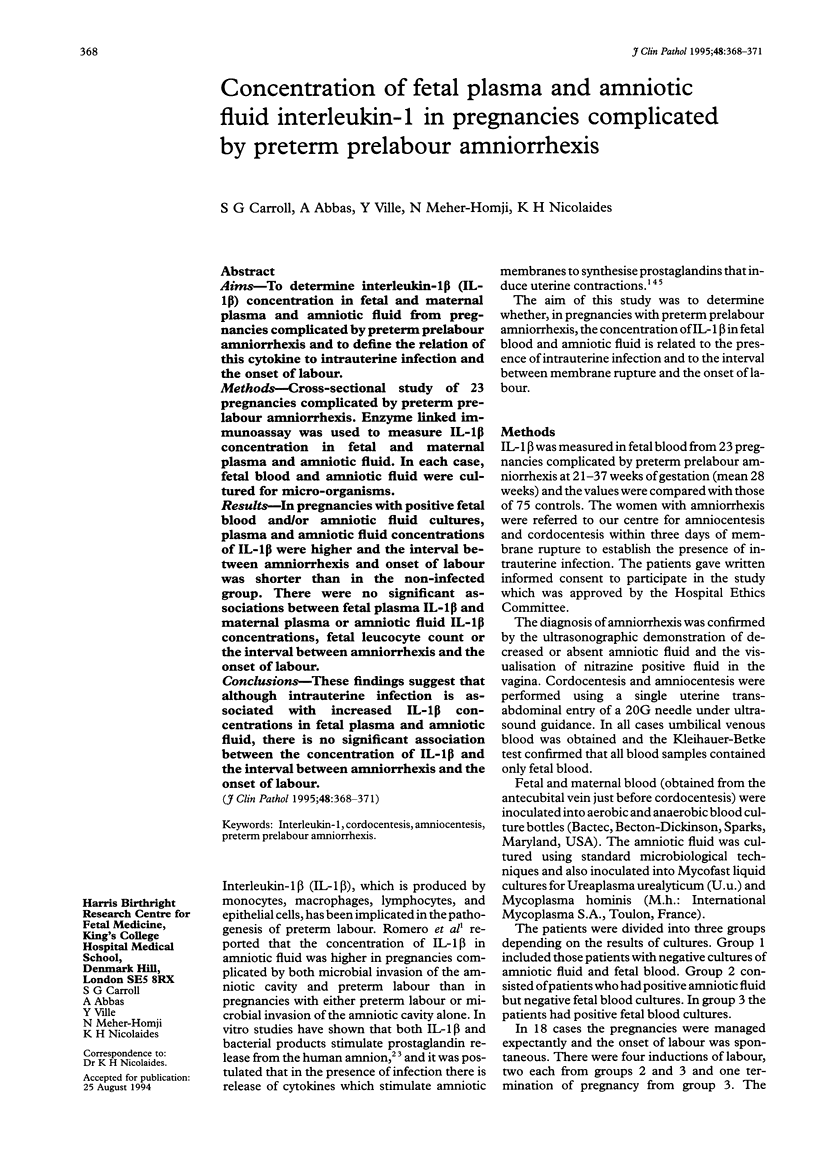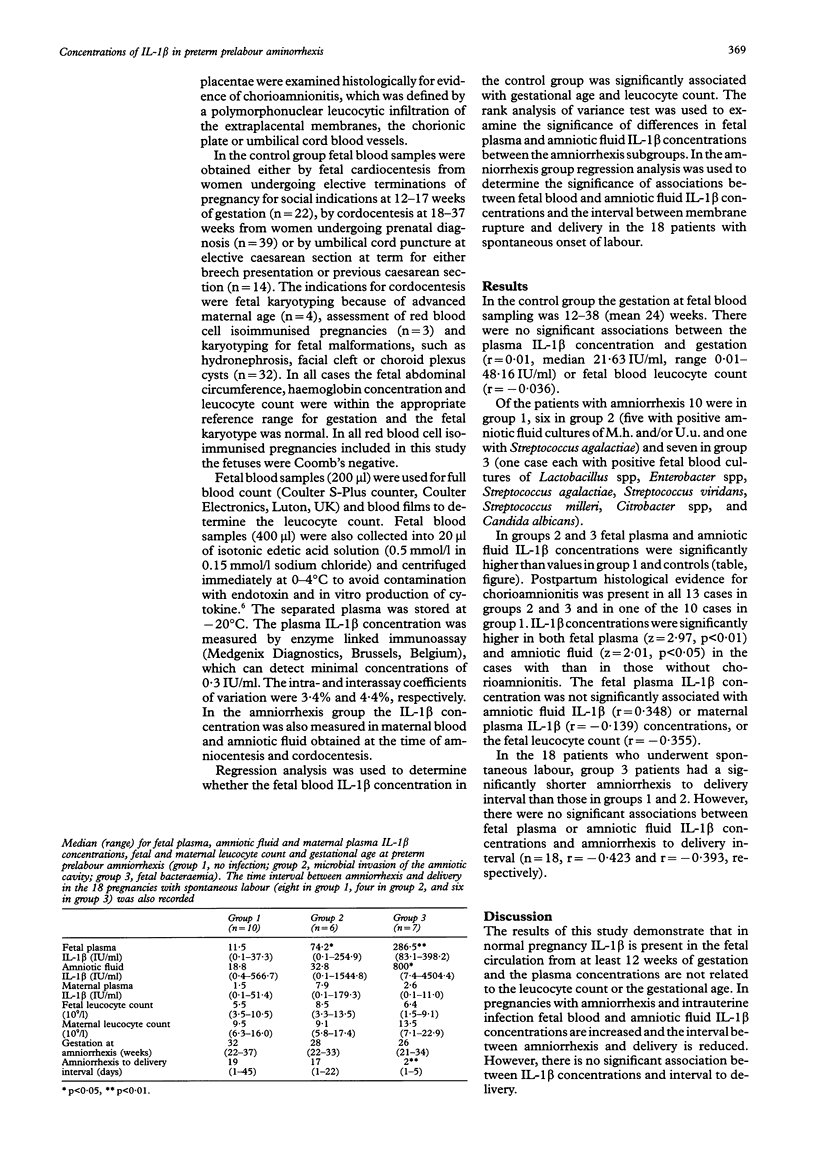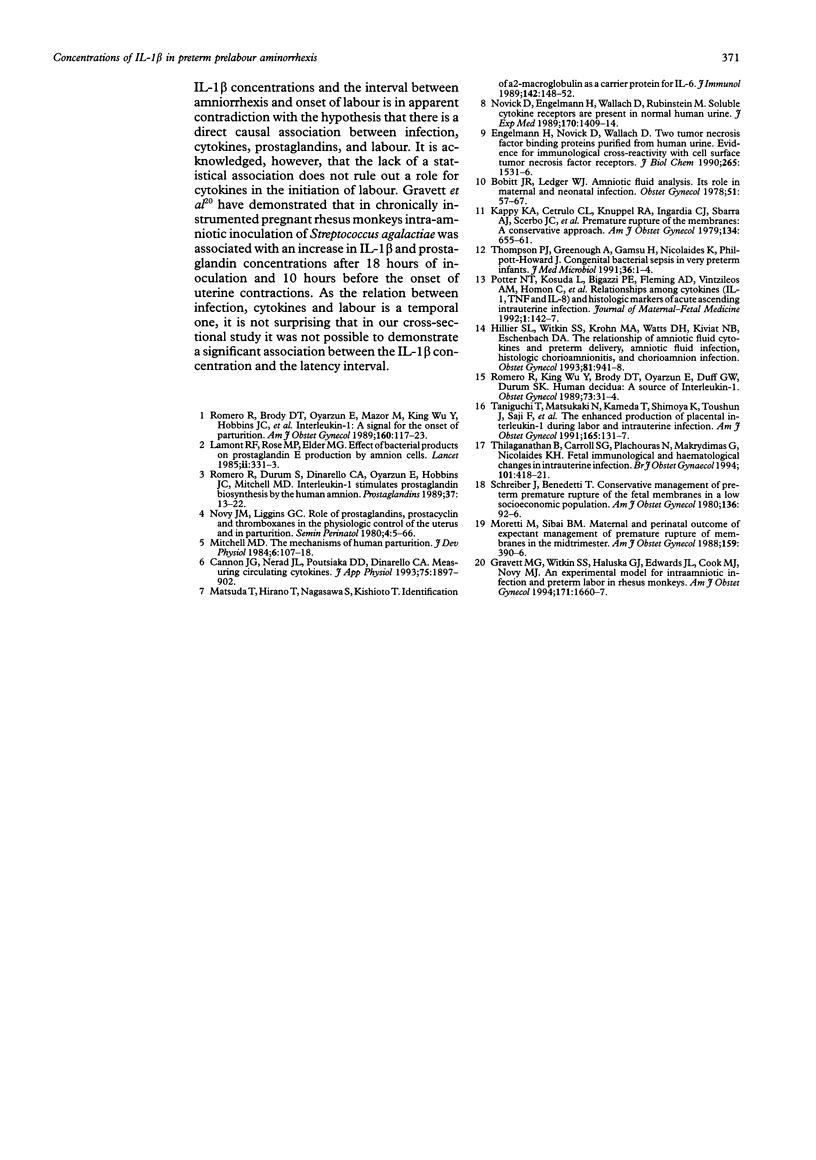Abstract
AIMS--To determine interleukin-1 beta (IL-1 beta) concentration in fetal and maternal plasma and amniotic fluid from pregnancies complicated by preterm prelabour amniorrhexis and to define the relation of this cytokine to intrauterine infection and the onset of labour. METHODS--Cross-sectional study of 23 pregnancies complicated by preterm prelabour amniorrhexis. Enzyme linked immunoassay was used to measure IL-1 beta concentration in fetal and maternal plasma and amniotic fluid. In each case, fetal blood and amniotic fluid were cultured for micro-organisms. RESULTS--In pregnancies with positive fetal blood and/or amniotic fluid cultures, plasma and amniotic fluid concentrations of IL-1 beta were higher and the interval between amniorrhexis and onset of labour was shorter than in the non-infected group. There were no significant associations between fetal plasma IL-1 beta and maternal plasma or amniotic fluid IL-1 beta concentrations, fetal leucocyte count or the interval between amniorrhexis and the onset of labour. CONCLUSIONS--These findings suggest that although intrauterine infection is associated with increased IL-1 beta concentrations in fetal plasma and amniotic fluid, there is no significant association between the concentration of IL-1 beta and the interval between amniorrhexis and the onset of labour.
Full text
PDF



Selected References
These references are in PubMed. This may not be the complete list of references from this article.
- Cannon J. G., Nerad J. L., Poutsiaka D. D., Dinarello C. A. Measuring circulating cytokines. J Appl Physiol (1985) 1993 Oct;75(4):1897–1902. doi: 10.1152/jappl.1993.75.4.1897. [DOI] [PubMed] [Google Scholar]
- Engelmann H., Novick D., Wallach D. Two tumor necrosis factor-binding proteins purified from human urine. Evidence for immunological cross-reactivity with cell surface tumor necrosis factor receptors. J Biol Chem. 1990 Jan 25;265(3):1531–1536. [PubMed] [Google Scholar]
- Gravett M. G., Witkin S. S., Haluska G. J., Edwards J. L., Cook M. J., Novy M. J. An experimental model for intraamniotic infection and preterm labor in rhesus monkeys. Am J Obstet Gynecol. 1994 Dec;171(6):1660–1667. doi: 10.1016/0002-9378(94)90418-9. [DOI] [PubMed] [Google Scholar]
- Hillier S. L., Witkin S. S., Krohn M. A., Watts D. H., Kiviat N. B., Eschenbach D. A. The relationship of amniotic fluid cytokines and preterm delivery, amniotic fluid infection, histologic chorioamnionitis, and chorioamnion infection. Obstet Gynecol. 1993 Jun;81(6):941–948. [PubMed] [Google Scholar]
- Kappy K. A., Cetrulo C. L., Knuppel R. A., Ingardia C. J., Sbarra A. J., Scerbo J. C., Mitchell G. W. Premature rupture of the membranes: a conservative approach. Am J Obstet Gynecol. 1979 Jul 15;134(6):655–661. doi: 10.1016/0002-9378(79)90647-1. [DOI] [PubMed] [Google Scholar]
- Matsuda T., Hirano T., Nagasawa S., Kishimoto T. Identification of alpha 2-macroglobulin as a carrier protein for IL-6. J Immunol. 1989 Jan 1;142(1):148–152. [PubMed] [Google Scholar]
- Mitchell M. D. The mechanism(s) of human parturition. J Dev Physiol. 1984 Feb;6(1):107–118. [PubMed] [Google Scholar]
- Moretti M., Sibai B. M. Maternal and perinatal outcome of expectant management of premature rupture of membranes in the midtrimester. Am J Obstet Gynecol. 1988 Aug;159(2):390–396. doi: 10.1016/s0002-9378(88)80092-9. [DOI] [PubMed] [Google Scholar]
- Novick D., Engelmann H., Wallach D., Rubinstein M. Soluble cytokine receptors are present in normal human urine. J Exp Med. 1989 Oct 1;170(4):1409–1414. doi: 10.1084/jem.170.4.1409. [DOI] [PMC free article] [PubMed] [Google Scholar]
- Novy M. J., Liggins G. C. Role of prostaglandins, prostacyclin, and thromboxanes in the physiologic control of the uterus and in parturition. Semin Perinatol. 1980 Jan;4(1):45–66. [PubMed] [Google Scholar]
- Romero R., Durum S., Dinarello C. A., Oyarzun E., Hobbins J. C., Mitchell M. D. Interleukin-1 stimulates prostaglandin biosynthesis by human amnion. Prostaglandins. 1989 Jan;37(1):13–22. doi: 10.1016/0090-6980(89)90028-2. [DOI] [PubMed] [Google Scholar]
- Romero R., Wu Y. K., Brody D. T., Oyarzun E., Duff G. W., Durum S. K. Human decidua: a source of interleukin-1. Obstet Gynecol. 1989 Jan;73(1):31–34. [PubMed] [Google Scholar]
- Schreiber J., Benedetti T. Conservative management of preterm premature rupture of the fetal membranes in a low socioeconomic population. Am J Obstet Gynecol. 1980 Jan 1;136(1):92–96. doi: 10.1016/0002-9378(80)90572-4. [DOI] [PubMed] [Google Scholar]
- Taniguchi T., Matsuzaki N., Kameda T., Shimoya K., Jo T., Saji F., Tanizawa O. The enhanced production of placental interleukin-1 during labor and intrauterine infection. Am J Obstet Gynecol. 1991 Jul;165(1):131–137. doi: 10.1016/0002-9378(91)90241-i. [DOI] [PubMed] [Google Scholar]
- Thilaganathan B., Carroll S. G., Plachouras N., Makrydimas G., Nicolaides K. H. Fetal immunological and haematological changes in intrauterine infection. Br J Obstet Gynaecol. 1994 May;101(5):418–421. doi: 10.1111/j.1471-0528.1994.tb11915.x. [DOI] [PubMed] [Google Scholar]


